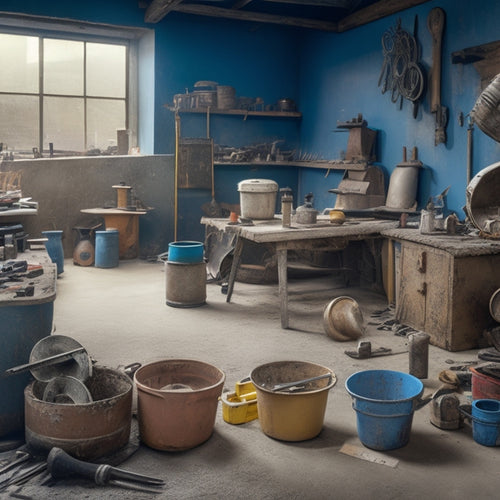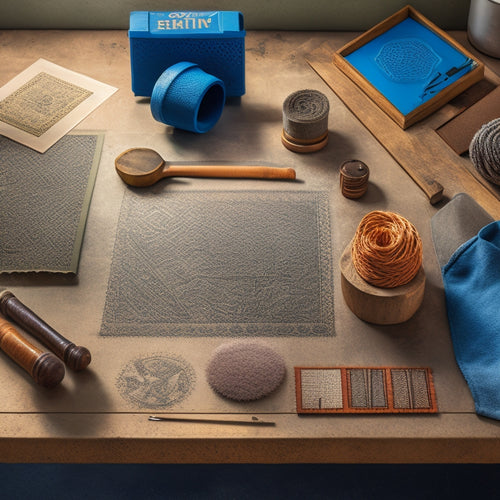
3 Best Tools for Preparing Concrete for Paint
Share
When preparing concrete for paint, you'll need the right tools to remove dirt, grime, and old coatings. A powerful pressure washer with a minimum 3,000 PSI is essential for effective cleaning. For tough, stuck-on debris, a concrete scraper is a must-have, with options ranging from handheld to walk-behind models. Finally, a specialized surface preparation brush with stiff bristles and an angled head will help you reach corners and crevices. With these three tools in your arsenal, you'll be well-equipped to tackle the job - and by understanding the specifics of each tool, you'll be able to tackle even the toughest concrete preparation projects.
Key Takeaways
• A pressure washer with a minimum of 3,000 PSI is necessary for effective dirt and grime removal from concrete surfaces.
• Electric or gas pressure washers can be used, with gas models providing more power for larger projects.
• A concrete scraper, either handheld, electric, or walk-behind, should be selected based on the surface area to be cleaned.
• Specialized surface preparation brushes with stiff bristles and angled heads are designed for thorough cleaning and etching of concrete surfaces.
• Safety gear, including gloves, safety glasses, and face masks, should be worn when using these tools to prepare concrete for painting.
Powerful Pressure Washer Options
You'll need a powerful pressure washer capable of generating at least 3,000 pounds per square inch (PSI) to effectively remove dirt, grime, and old coatings from the concrete surface. This level of pressure is necessary to break down and remove stubborn substances that can interfere with paint adhesion.
When selecting a pressure washer, you'll need to decide between electric pressure and gas pressure models. Electric pressure washers are generally quieter, lighter, and more environmentally friendly, but may not provide the same level of power as gas-powered models. Gas pressure washers, on the other hand, offer more power and are often better suited for larger, more demanding projects.
Regardless of which type you choose, make sure to wear appropriate safety gear, including gloves, safety glasses, and a face mask, to protect yourself from high-pressure spray and debris. Always follow the manufacturer's instructions and take necessary precautions to avoid accidents.
Effective Concrete Scraper Tools
Two essential concrete scraper tools for removing old coatings and roughening the surface are the handheld scraper and the walk-behind scraper.
When using a handheld scraper, you'll employ manual scraping techniques, which can be time-consuming but effective for small areas. However, for larger areas, you'll want to take into account an electric scraper, which offers several advantages. Electric scrapers are faster and more efficient, allowing you to cover more ground in less time. They also reduce the physical strain associated with manual scraping, making them a safer option for your body.
When choosing an electric scraper, think about the size of the area you need to cover and the type of surface you're working with. Walk-behind scrapers are ideal for large areas, while handheld electric scrapers are better suited for smaller spaces.
Regardless of which type you choose, make sure to follow safety guidelines, such as wearing protective gear, including gloves and safety glasses, and working in a well-ventilated area. By using the right concrete scraper tool for the job, you'll be able to effectively remove old coatings and prepare your surface for painting.
Specialized Surface Preparation Brushes
Specialized surface preparation brushes, equipped with stiff bristles and angled heads, aggressively remove dirt, grime, and old coating residue, allowing for a more thorough cleaning and etching of the concrete surface. When you use these brushes, you'll notice they're designed to tackle tough surfaces, producing a texture that's ideal for paint adhesion. The stiff bristles are typically made from durable materials like nylon or polypropylene, which can withstand the rigors of scrubbing concrete without compromising their shape or performance.
As you work with these brushes, you'll appreciate their ability to reach into corners and crevices, ensuring a detailed cleaning process. The angled heads also allow for more efficient coverage, reducing the time and effort required to prepare the surface. By selecting the right brush material for your specific project, you'll achieve a surface texture that's perfectly suited for painting.
Remember to always follow safety guidelines when using these brushes, wearing protective gear like gloves and safety glasses to prevent injury. With the right brush and a bit of elbow grease, you'll be well on your way to a beautifully painted concrete surface.
Frequently Asked Questions
Can I Use a Regular Broom to Sweep the Concrete Before Painting?
When sweeping concrete before painting, you'll want to avoid using a regular broom. Its soft bristles can push dirt and debris around, leaving a rough surface.
Instead, opt for a stiff-bristled broom or a push broom specifically designed for concrete. Use gentle, overlapping sweeping techniques to remove dirt and dust, working in sections to maintain control.
This guarantees a smooth surface for painting, reducing the risk of imperfections and safety hazards.
How Do I Know if My Concrete Is Ready for Painting?
You've swept the concrete until it's spotless, but now you're wondering if it's ready for paint.
Don't assume it's a done deal just yet! You need to verify the surface is completely dry and free of moisture.
It's like finding a needle in a haystack, but trust us, it's worth it. Perform a moisture testing to confirm the concrete is bone-dry.
Only then can you proceed with surface preparation, and finally, painting.
Do I Need to Prime the Concrete Before Applying Paint?
You're wondering if you need to prime the concrete before applying paint. The answer is yes, you should.
Priming guarantees a strong bond between the concrete and paint, reducing peeling and flaking. It also fills pores, creating a smooth surface.
Choose a primer suitable for your concrete type and environmental conditions. Consider epoxy-based, acrylic, or silane-based primers.
Don't skip this vital step – it's essential for a durable, long-lasting finish that's safe and resistant to wear and tear.
Can I Paint Over Existing Concrete Stains or Should I Remove Them?
As you stand before the worn, stained concrete, it's like gazing at a canvas marred by imperfections.
Now, you're wondering if you can simply paint over those unsightly stains or if removal is the way to go. The answer lies in the paint adhesion factors.
If you don't use proper stain removal techniques, the paint may not bond well, leading to peeling and flaking. It's essential to remove those stains to guarantee a strong, durable finish.
Don't gamble with the outcome - take the time to prep the surface correctly for a safe, long-lasting result.
How Long Does It Take for the Concrete to Dry After Power Washing?
When you power wash concrete, it's essential to allow it to dry properly to guarantee a safe and effective paint job.
The drying time depends on various factors, including the power washing techniques you use, ambient temperature, humidity, and the concrete's porosity.
As a general rule, you should wait at least 24 to 48 hours for the concrete to fully dry before applying paint.
Always follow safety guidelines and take necessary precautions to avoid slipping hazards during the drying process.
Conclusion
You've prepped your concrete surface to perfection, and now it's ready for a fresh coat of paint.
But don't underestimate the importance of proper preparation - it's essential for a durable, long-lasting finish. Did you know that a staggering 80% of coating failures are attributed to inadequate surface preparation?
By investing in the right tools, like powerful pressure washers, effective concrete scrapers, and specialized surface preparation brushes, you can guarantee a strong bond between the concrete and paint.
Related Posts
-

Top Tools for Mixing Concrete at Home
When mixing concrete at home, you'll need a range of tools to guarantee a successful operation. Start with essential ...
-

Best Tools for Concrete Restoration and Repair
When tackling concrete restoration and repair projects, you need a range of reliable tools to achieve professional-gr...
-

5 Best Tools for Stamping Concrete Walls
When it comes to stamping concrete walls, you'll need a range of specialized tools to achieve the desired texture and...


